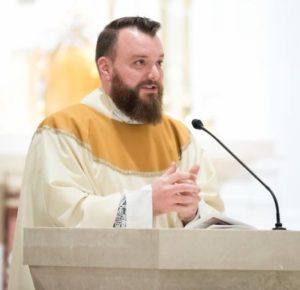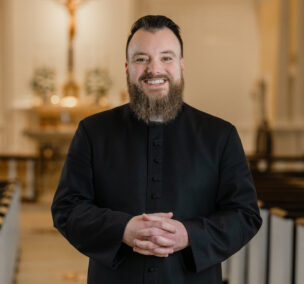 Dear Brothers and Sisters in Christ,
Dear Brothers and Sisters in Christ,
As we received ashes this week, we heard those powerful, essential words “Repent, and believe in the Gospel.” To repent means to turn our backs on sin, to turn our whole spiritual orientation away from sinful ideas, actions, and attitudes, to return to the right path. To turn away from sin is not a neutral act. It demands a turning toward something, namely a turning toward God. Lent, then, is a time to re-orient our lives so that the focus of our attention, thoughts, and actions can be on the Lord.
Our orientation facing God is, of course, a primarily spiritual reality. But as incarnate beings, we have bodies that can express the interior reality in a beautiful way. Consider how we enter the church. After walking through the door, our eyes are drawn not to scan the crowd for available seats, but to the Cross. With our eyes fixed on the Cross, we immediately notice the Tabernacle and the lamp that burns next to it, reminding us of the presence of Jesus in the Blessed Sacrament. Even if our minds are elsewhere as we come into the church, some part of our being is drawn to God in a real way. Before taking a seat, we genuflect. That genuflection is directed not to the side, nor to the pew, but to Jesus present for us in the sanctuary. Our whole body is thus involved in this orientation toward the Lord. When we sit, stand, or knee, as we listen and as we respond with voice, our body is drawn into worship and is physically oriented to the Lord. This physical orientation is both a reflection of and an aid to an interior disposition, oriented to God at the level of the heart.
The physical layout of the Church is often described using an east-west axis. The altar stands at the east. East is the direction from which the sun rises. Jesus seems to hint that His second coming will be from the East (cf. Mt. 24:27). Looking to the East, to the altar, to the tabernacle, we look to Jesus. We see the Crucifix, a sign of hope and a reminder of God’s infinite, merciful love poured out, and we see the way in which that love continues to be poured out: in every Mass celebrated on the altar we stand at the foot of the Cross and receive the Body and Blood of Jesus, the gift of love offered for us. Even when the altar is not at a geographical east (as ours is not geographically to the east), the whole congregation is, in a symbolic way, oriented to the east as we worship. This orientation is a physical reminder of what is supposed to happen interiorly for each of us – we are to turn away from sin and toward Jesus. As we sit listening to the Word of God proclaimed, we hear it coming from the ambo, which is situated on the northern side of the sanctuary (if we consider the altar “east”). In the Extraordinary Form of the Mass, the priest actually stands at an angle, symbolically facing north. In solemn high Masses in the Extraordinary Form the symbolism is even more stark, as the Gospel is carried out of the sanctuary and read by the deacon while he turns completely to the north. The Good News of Jesus Christ, the light coming from the east, is proclaimed to that direction where the light does not shine. This reminds us that the light of the Gospel is meant to enlighten the darkness of our own lives. We listen to it while facing east, facing the light, facing the goodness and mercy of God offered to us.
The phrase “ad orientem” is Latin for “toward the east.” Catholic worship is always ad orientem, even when that east is only symbolic. Every Mass is meant to orient us to Jesus. “Repent, and believe in the Gospel.” Turn away from sin, turn toward the Lord. The reorientation of life and heart demanded by our encounter with Jesus is something that we symbolically live out every time we come into the church, every time we worship at Mass. If this is all true, then we must examine our own hearts asking if we are aware of this truth? Most likely, we are not. Good news! Lent is a season for training and for reminders. During these 40 days of prayer, fasting, and almsgiving, the words of Ash Wednesday will echo in our minds: “Repent, and believe in the Gospel.” For forty days we will examine what it means to turn from sin and to turn toward the Lord. For forty days, we will reflect on how our worship Sunday after Sunday is, in fact, a turn to the east, a reorientation of our lives away from sin and death and toward life. These forty days will train us to turn our gaze to the Lord, to practice the dispositions of mind, heart, and body, that make this orientation possible. Lent gives us a particular season to consider this orientation, but the Mass is a constant reminder of how we want to orient our lives. During Lent we will continue this reflection on the orientation of our lives toward the Lord, and the orientation of our communal worship toward the Lord.
Peace,

Fr. Sam


